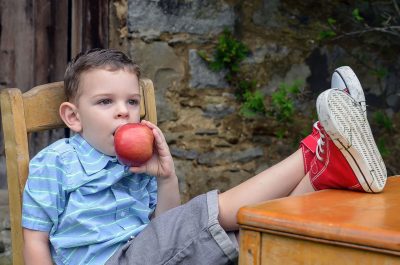COVID-19 AND NUTRITION
It can be challenging to find the time and energy to prepare healthy foods even on the best of days. For many of us, COVID-19 has added additional levels of stress—food sourcing, cleaning, storing and preparing safely can all be challenging and time-consuming. Join us to talk about ways to simplify, save time, and eat well while we choose and prepare foods that satisfy our COVID-19 cravings!
Due to self-quarantines and social distancing, we thought it would be a great opportunity to answer some common food and nutrition questions related to our current food environment. Please read more (PDF) from Melissa Walter, LDN in the Gillings School Nutrition Department.
MINDFUL MUSINGS
Holiday Eating with Intention
Anna Claire Tucker, MPH-RD Candidate, Department of Nutrition, Gillings School

A mindful meal is a healthy meal.
Think back to the best thing you ever ate. You can probably describe it in vivid detail. Mine has to be my grandmother’s blackberry cobbler: the soft golden crust, juicy blackberries, and cool Blue Bell vanilla ice cream on a warm summer evening. Memories like these stick with us because we were immersed in the experience, but how often are you truly immersed in your meal? No television, no emails, no homework, no social media. Many of us may struggle to remember a meal without distractions. An undistracted meal seems radical in a society that idolizes busyness. Booked schedules and multi-tasking are seemingly synonymous with hard work and our own self-worth. Yet an undistracted meal—a mindful meal—matters. Regardless of what we eat, how we eat is just as important. Read more/less.
Mindful eating can be broken down into 4 core principles1:
- Developing an awareness of physical hunger and fullness cues
- Slowing down and minimizing distractions
- Savoring food using all five senses
- Acknowledging feelings about food without judgment
Becoming aware of our eating choices is the first step towards mindful eating. The next time you reach for food, ask yourself: “Why? What do I feel physically and emotionally? Am I really hungry?” You might be, but you might just be bored, stressed, or procrastinating. You may reach for food from habit or because the people around you are eating. Whatever your reason, mindful eating does not dictate whether or not you eat. Instead, it asks us to make a decision not governed by habit or impulse. So if you still want the cookie, take it…just know why you did.
You probably remember scarfing down a sandwich while typing on a computer, only to realize the sandwich is gone and you’re still unsatisfied. Or maybe you don’t remember, because hurried, distracted eating is such a frequent routine in contemporary life. Mindful eating calls us to slow down and minimize these distractions. Though it isn’t about the outcome, this can have practical benefits.
Studies have shown mindful eating can decrease overeating and emotional eating3. Specifically, slowing down and focusing helps us manage stress and reduces eating in response to external cues such as package size and social setting3. These cues constantly shape our eating choices. We cannot change many of them, but we can increase our awareness which enables us to make conscious, autonomous choices less influenced by external forces.
In the coming weeks, give mindful eating a try. Slow down. Savor your food. Contemplate every sight, sound, flavor, texture, and aroma. Whatever thoughts and feelings arise, acknowledge these, but resist the urge to judge them or yourself because of them. While we can’t muse over mac n cheese for 20 minutes every day, we can bring awareness to our actions and find peace with all food choices.
If we are fortunate enough to have adequate access to food, eating should not be a source of stress, contention, or guilt. Mindful eating is an opportunity to set aside those negative feelings and develop a more positive relationship with food. Who knows, with a little bit of mindfulness, your morning cereal might just be the next best thing you ever ate.
- “The Center for Mindful Eating – Principles of Mindful Eating.” Accessed November 7, 2020. https://www.thecenterformindfuleating.org/Principles-Mindful-Eating.
- Nelson, Joseph B. “Mindful Eating: The Art of Presence While You Eat.” Diabetes Spectrum : A Publication of the American Diabetes Association 30, no. 3 (August 2017): 171–74. https://doi.org/10.2337/ds17-0015.
- Warren, Janet M., Nicola Smith, and Margaret Ashwell. “A Structured Literature Review on the Role of Mindfulness, Mindful Eating and Intuitive Eating in Changing Eating Behaviours: Effectiveness and Associated Potential Mechanisms.” Nutrition Research Reviews 30, no. 2 (December 2017): 272–83. https://doi.org/10.1017/S0954422417000154.
Eat Smart Move More Weight Less
Eat Smart Move More Weigh Less is an online weight management program that uses strategies proven to work for weight loss and maintenance. Each lesson informs, empowers and motivates participants to live mindfully as they make choices about eating and physical activity. Eat Smart, Move More, Weigh Less is delivered in an interactive real-time format with a live instructor. The program is offered to those interested in eating smart, moving more, and achieving a healthy weight. Each series is 15-weeks. Act fast, series fill up fast! Each weekly session is covered at 100% as a telehealth group nutritional counseling visit. You will be asked to enter your BCBSNC, State Health Plan, subscriber ID#. Your primary insurance provider must be BCBSNC.
